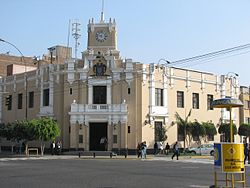|
La Victoria District, Lima
La Victoria is one of the forty-three districts that make up the province of Lima, located in Peru. It borders to the north and northeast with the district of Lima, to the east with the district of San Luis, to the southeast with the district of San Borja, to the south with the district of San Isidro, and to the west with the district of Lince and again with the Lima district. La Victoria is a historical and very busy public district located in downtown Lima. The current mayor of La Victoria is Rubén Dioscorides Andrés Cano Altez. From the hierarchical point of view of the Catholic Church, it is part of the Episcopal Vicariate V of the Archdiocese of Lima.[2] Overview La Victoria has several sections:
La Victoria is home to one of the most popular football teams in Peru, Alianza Lima. The Alejandro Villanueva Stadium is located near the housing project Hooch in the southern part of La Victoria. Today's La Victoria offers residents and visitors parks and cultural attractions. HistoryUntil 1920, when it was made into a separate district, La Victoria was separate from Miraflores, Lima and Ate districts. Industry began to grow in 1889, when the Italian Bartolomé Boggio and the American Enrique Price founded the Santa Catalina Fabric Factory.[3] With the arrival of migrants from the interior of the country seeking work in the capital, the capital's two economic centers – La Parada for edible products and Gamarra for textile products – were created.[4] District structureLa Victoria is located south of the historic center of Lima. It is bordered to the north by the district of Lima through Miguel Grau Avenue and part of 28 de Julio Avenue; to the east by the El Agustino district through Cerro San Pedro, the San Luis district through Nicolás Arriola Avenue and part of Aviación Avenue, and the San Borja district through Luis Aldana Avenue and part of Canada Avenue; to the south by the district of San Isidro through Javier Prado Este Avenue and part of Paseo de la República Avenue; and to the west by the Lince and Lima districts through the entire Paseo de la República Avenue. The main roads in this district are Manco Cápac Avenues (the oldest in the district), México, Isabel la Católica, Parinacochas, Iquitos, 28 de Julio, Aviación, Nicolás Arriola, Canada, Nicolás Ayllón and part of Circunvalación Avenue. La Victoria has a great commercial focus. The area of the district located north of Mexico Avenue is primarily commercial;[5] in it the Gamarra Emperium stands out, which is the headquarters of the largest textile industry in Lima and has numerous stores, shopping centers and clothing workshops mainly in the vicinity of Agustín Gamarra Street. The food markets of La Parada and the Fruit Market also operate in this area. In addition, several commercial and interprovincial land transport companies have their headquarters in this sector. To the south of Avenida México, residential areas of a medium-high socioeconomic level are predominant, such as Balconcillo and Santa Catalina.[6] The first is characterized by its central park called Unión Panamericana and borders the avenues México, Parinacochas, Canada and Paseo de la República, while the second is characterized by its rapid real estate development which has increased the number of high-rise housing buildings.[7] Among its most important educational centers are the Pedro A. Labarthe, Felipe Santiago Salaverry, Sagrada Familia, Paul Harris and Isabel La Católica national schools. The first national school, formerly called Nuestra Señoras de Las Victorias, and the José Granda men's school, currently called República de Panamá, is located near the Plaza Manco Capac and is the oldest school in the district. There are also private schools such as América de La Victoria, San Ricardo, Reina de las Américas (Balconcillo), San Norberto (Santa Catalina), Nuestra Señora del Pilar (Santa Catalina). There are also the Professional Academic School of Obstetrics of the San Fernando School of Medicine at the National University of San Marcos, the José Pardo Technological Institute, the headquarters of the Peruvian Institute of Nuclear Energy and the Institute of Graphic Arts. The main Catholic church is Nuestra Señora de las Victorias, located along with the district municipality's headquarters in the central Plaza Manco Cápac, whose monument was donated in 1926 by the Japanese colony in Peru on the occasion of the centenary of Peru's independence. It also has other churches such as those of San Ricardo, in Matute (which has a public swimming pool), San Antonio María Claret, Nuestra Señora del Buen Consejo, San Norberto (consecrated on July 15, 1963, in the Santa Catalina urbanization), in addition to the Our Lady of Guadalupe Parish Sanctuary in the Balconcillo urbanization. Among the district's hospital infrastructure is the old Hospital Obrero, today known as the Guillermo Almenara Irigoyen National Hospital, which belongs to the Social Security of Peru and is located on Avenida Grau. Additionally, La Victoria has a shelter for the underprivileged called Hogar de la Paz that is administered by the Missionaries of Charity. A place of interest in the district is the Calvetti house located at the intersection of Hipólito Unanue and Iquitos Avenue. It features the longest balcony in Peru, with a length of 99.22 m (325.5 ft) and which was built in 1924.[8][9] AuthoritiesMunicipal
Police
Religious
Festivities
References
External links
|
||||||||||||||||||||||||||||||||||||||||||||


